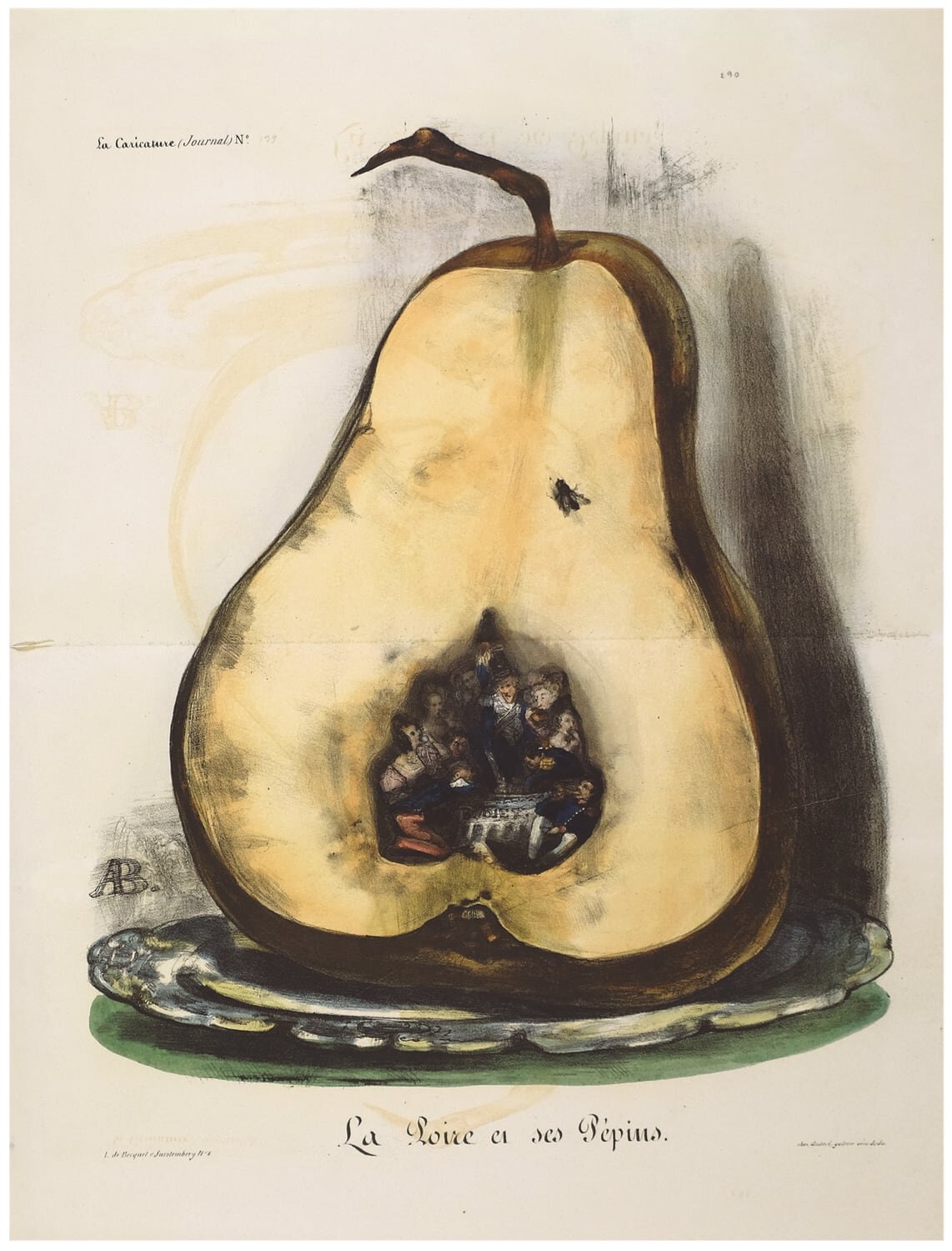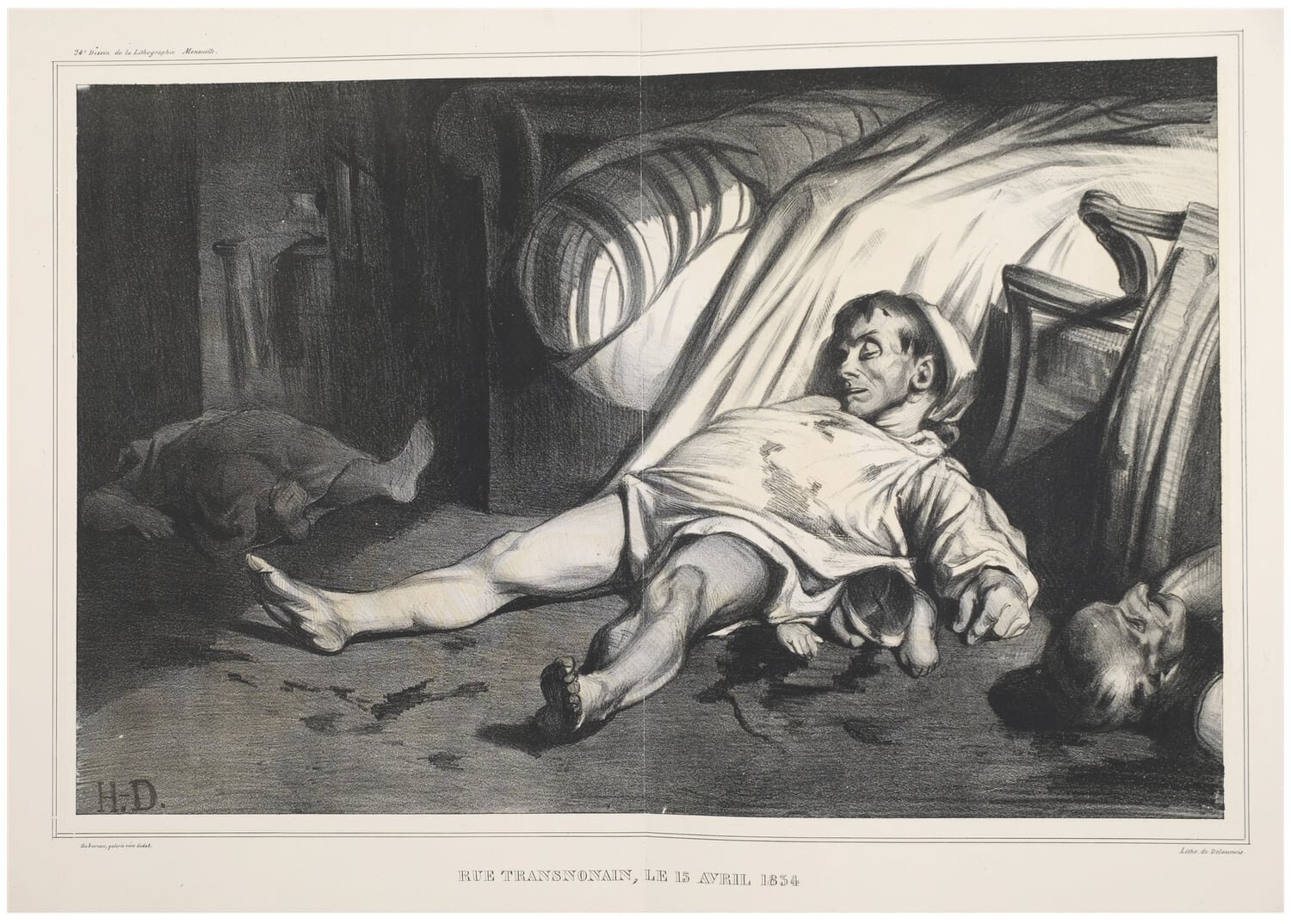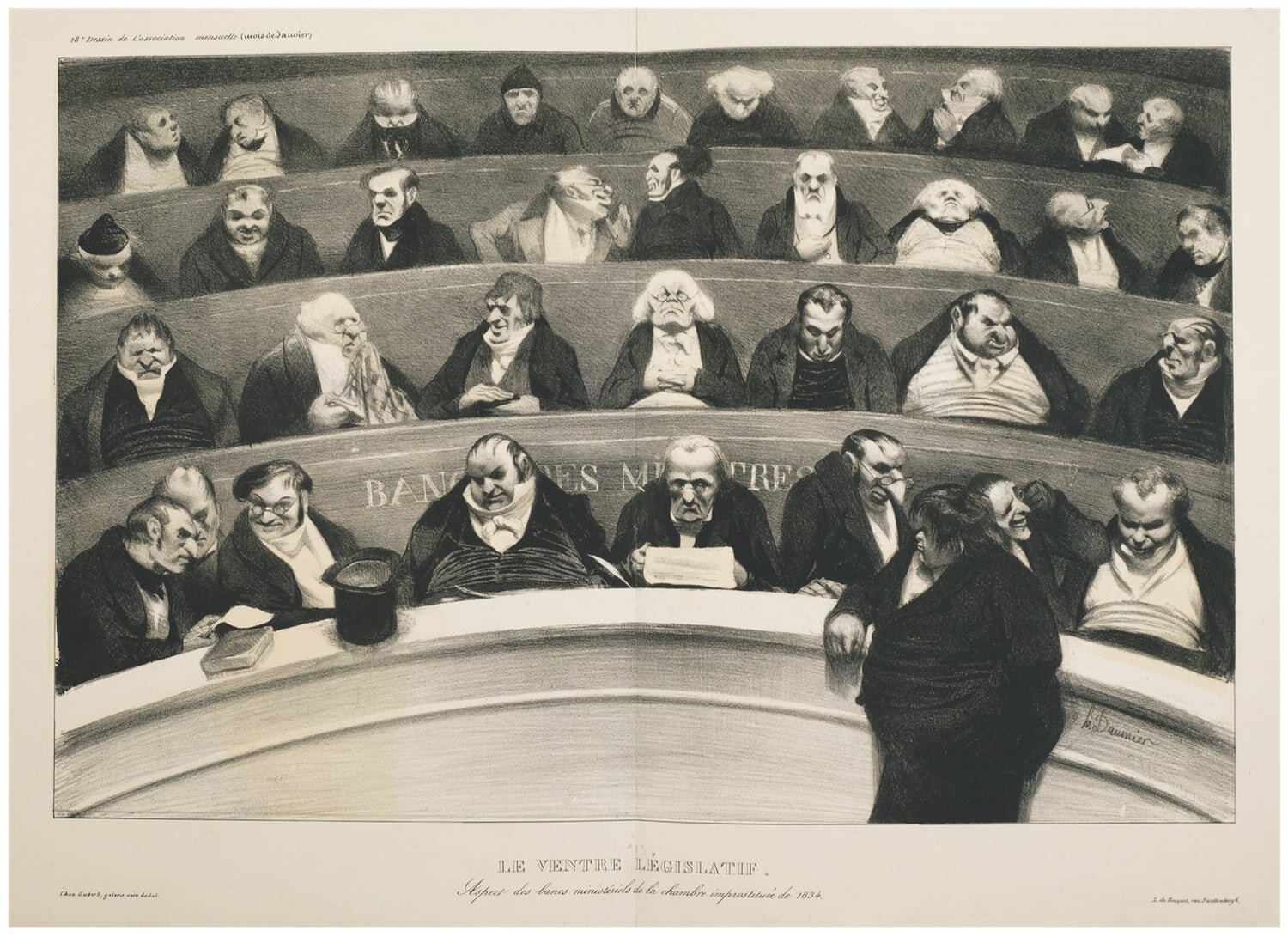IX. La Caricature
IX. La Caricature
The Most Important Illustrated Satirical Periodical of the 19th Century (1830-35)
The July Revolution of 1830 brought an end to the Restoration period of the Bourbons, and brought to power the "Citizen King" Louis-Philippe I, in whom the politically underrepresented middle class invested their hopes. During the revolution, the press had already played a significant role, and once freedom of the press was declared, the subversive publisher Charles Philipon saw an opportunity for a satirical weekly publication that would comment current affairs from a Republican point of view.
The first issue of La Caricature was published in 1830, but by the beginning of 1831, press laws were again restricted, and the new government under Casimir Périer declared war on the opposition, and so La Caricature, too, went on the offensive. The "Citizen King" in particular, the former bearer of hope, incurred the indignation of the disappointed citizenry. Thus began a battle on unequal footing, like David against Goliath: in the clash of “Philipon versus Philippe”, the journalist immortalised the monarch as Roi Poire, the Royal Pear: Honoré Daumier’s drawing depicting the metamorphosis of the King’s face into a pear in four stages was presented in court as evidence by Philipon when he was charged with “outrage against the person of the King”. Entitled Croquades Faites à l'audience du 14 nov. (Cour d'Assis) the illustration was shortly added to the issue of November 24, and the pear became an often-repeated shorthand in satirical depictions of the king.
As consequence of his insubordinations, Philipon faced constant legal charges, trials, fines and seizures. In 1832, in order to raise funds for the publication, he founded the Association mensuelle pour la liberté de la presse, which issued a monthly large lithograph as an appendix to La Caricature. Among them were five famous prints by Daumier, whose lithograph Rue Transnonain shows a bourgeois family murdered in their home, and is considered one of the greatest printed graphic works of art.
After an assassination attempt on Louis-Philippe in July of 1835 killed 18 people, the king placed some of the blame on the oppositional press. The “September laws” that were consequently introduced soon after, further limited the press, and, crucially, outlawed all political caricature. As a result, La Caricature published the last of its 251 issues on 27 August, 1835. In the last instalment, Daumier depicted those that lost their lives in the July revolution as rising from their graves and lamenting the futility of their sacrifice.
From an art historical perspective, the periodical with its over 500 lithographs represents the pinnacle of 19th-century French pictorial satire. In opposition to the official art of the Academy, the circle of artists who worked on La Caricature, including Honoré Daumier, Grandville, Gavarni, Cham, Charlet, Achille Devéria , Henri Monnier, Charles Joseph Traviès, and Auguste Raffet, developed a new artistic language that greatly influenced the development of satirical as well as realistic art, as is evident in Traviès' representations of proletarians and social outsiders.
The complete copy with uncoloured lithographs on China paper, as well as various additional material, bound in eleven volumes by Georges Mercier [no. 99] is of the greatest rarity. It is presented here alongside another extreme rarity, an unbound copy of all separate issues [no. 100], with plates on vellum paper, as well as a second set of plates, some printed on China paper and others with contemporary colouring, which once belonged to Adolphe Bordes.
This collection also includes five original pen drawings by Grandville [no. 283], the most important contributor to La Caricature, among them the template for a Lithographie mensuelle, depicting Charles Philipon riding a lion, jousting with a censor on a rooster, who, wounded by a stab of Philipon’s lancet/pen, topples to the ground.



![A complete copy of La Caricature , with uncoloured lithographs on China paper, as well as various additional material, bound in eleven volumes by Georges Mercier [no. 99]](https://images.squarespace-cdn.com/content/v1/5b02a5098ab7225ab8d3a10c/1591890229677-NAAC8X625CPKDQKEYZ94/99.jpg)
![A complete copy of La Caricature , with uncoloured lithographs on China paper, as well as various additional material, bound in eleven volumes by Georges Mercier [no. 99]](https://images.squarespace-cdn.com/content/v1/5b02a5098ab7225ab8d3a10c/1591890480692-56AR0VPO6ZZT5XP7LPG1/99_100a_1.jpg)
![A complete copy of La Caricature , with uncoloured lithographs on China paper, as well as various additional material, bound in eleven volumes by Georges Mercier [no. 99]](https://images.squarespace-cdn.com/content/v1/5b02a5098ab7225ab8d3a10c/1591890479979-FZ2YYYOM9AKAZ6TWB3J7/99_100a_2.jpg)
![A complete copy of La Caricature , with uncoloured lithographs on China paper, as well as various additional material, bound in eleven volumes by Georges Mercier [no. 99]](https://images.squarespace-cdn.com/content/v1/5b02a5098ab7225ab8d3a10c/1591890378797-BMNB8C3G94RGLC2H9AS0/99_100d.jpg)
![A complete copy of La Caricature , with uncoloured lithographs on China paper, as well as various additional material, bound in eleven volumes by Georges Mercier [no. 99]](https://images.squarespace-cdn.com/content/v1/5b02a5098ab7225ab8d3a10c/1591890379982-J8BYLYNJO382ILRXUWY3/99_100c.jpg)
![Coloured plates from an incredibly rare unbound copy of all separate issues of La Caricature [no. 100], once belonging to Adolphe Bordes](https://images.squarespace-cdn.com/content/v1/5b02a5098ab7225ab8d3a10c/1591890588831-PE7RBCHPBXZYG71IAJVL/99_100i.jpg)
![Coloured plates from an incredibly rare unbound copy of all separate issues of La Caricature [no. 100], once belonging to Adolphe Bordes](https://images.squarespace-cdn.com/content/v1/5b02a5098ab7225ab8d3a10c/1591890589404-GCUTS74UJDWRJS2L3IDO/99_100j.jpg)
![Original pen drawings by Grandville for La Caricature [no. 283]](https://images.squarespace-cdn.com/content/v1/5b02a5098ab7225ab8d3a10c/1591891141853-0CQ1U5V76Y0YQTIA2KRT/283a.jpg)
![Original pen drawings by Grandville for La Caricature [no. 283]](https://images.squarespace-cdn.com/content/v1/5b02a5098ab7225ab8d3a10c/1591891141677-VN7N02FB5FB8B648YDKU/283b.jpg)
![Original pen drawings by Grandville for La Caricature [no. 283]](https://images.squarespace-cdn.com/content/v1/5b02a5098ab7225ab8d3a10c/1591891226823-CNY7XV3GH17YJTNMQYYD/283e.jpg)
![Original pen drawings by Grandville for La Caricature [no. 283]](https://images.squarespace-cdn.com/content/v1/5b02a5098ab7225ab8d3a10c/1591891692017-Q9TI8X4YOCVSEHQY29AN/283f.jpg)
![Original pen drawings by Grandville for La Caricature [no. 283]](https://images.squarespace-cdn.com/content/v1/5b02a5098ab7225ab8d3a10c/1591891267339-WPC8FTEH80M9TA9C55CM/283g.jpg)
![Original pen drawings by Grandville for La Caricature [no. 283]](https://images.squarespace-cdn.com/content/v1/5b02a5098ab7225ab8d3a10c/1591891267121-OQZTL6NEM5TLYU2ZFM44/283h.jpg)